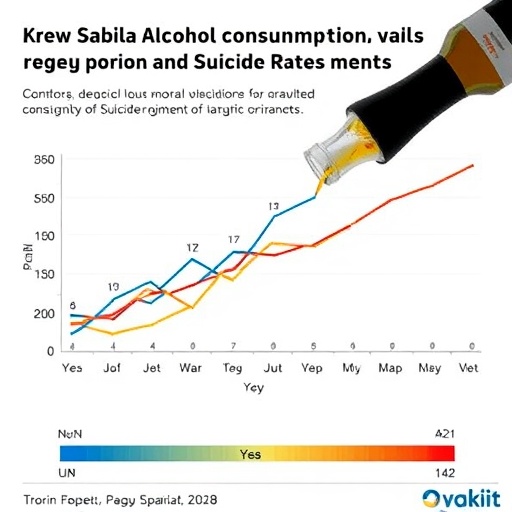A groundbreaking systematic review and meta-analysis has unveiled a strong, quantifiable link between per capita alcohol consumption and suicide mortality rates across populations worldwide. The comprehensive analysis draws a compelling correlation that transcends sex differences, indicating that increased alcohol use uniformly elevates suicide risk in both men and women. This pivotal finding underscores the significance of targeting alcohol consumption levels in public health strategies, particularly within the ambit of national suicide prevention frameworks.
Alcohol consumption has long been recognized as a detrimental factor affecting mental health, but this new research rigorously quantifies its impact on mortality due to suicide at the population level. Employing meta-analytic techniques, the study aggregates data from diverse epidemiological investigations to establish a nuanced understanding of how alcohol use fuels suicide deaths. The universality of the association across varied demographics emphasizes the pervasive influence of alcohol as a critical modifiable risk factor.
Delving into the methodology, the research involved a meticulous synthesis of peer-reviewed studies that report on suicide mortality in relation to alcohol consumption metrics. By applying advanced statistical models, such as random-effects meta-analyses, the investigators controlled for heterogeneity among studies while ensuring robustness of the aggregate effect size. This method allowed them to overcome potential confounders and derive conclusions with high external validity applicable to global populations.
Of particular note is the study’s finding that the relationship between alcohol consumption and suicide mortality remains consistent irrespective of sex. Historically, suicide rates and alcohol use patterns differ significantly between males and females, with men often exhibiting higher rates of both. This review, however, demonstrates that the increase in suicide risk linked to alcohol consumption is comparably elevated among women, signaling a critical area for gender-inclusive prevention efforts.
The implications of these findings are profound for public health policymakers and clinicians alike. By framing alcohol consumption as a predictive indicator of suicide trends, governmental agencies can prioritize alcohol reduction initiatives as part of integrated mental health programs. This approach heralds a shift from solely individual-centered interventions toward systemic, population-level strategies aimed at curbing alcohol-related harms and consequently reducing suicide rates.
Moreover, the study provides evidence supporting the use of per capita alcohol consumption statistics as an epidemiological surveillance tool. Monitoring these metrics offers real-time insights into potential fluctuations in suicide risk within communities, enabling timely and targeted preventive actions. Such data-driven models could revolutionize how public health responses are tailored to emerging crises involving substance use and mental health.
Scientifically, the intersection of behavioral psychology, epidemiology, and public health framing in this review reflects an interdisciplinary approach critical for addressing complex societal issues like suicide. By integrating knowledge domains—ranging from addiction science to demographic statistics—the research epitomizes how collaborative analytical techniques yield actionable knowledge for health interventions.
Beyond its direct findings, the study invites further inquiry into the underlying mechanisms that drive the alcohol-suicide linkage. Neurobiological, psychological, and social pathways likely interact in multifaceted ways, with alcohol potentially exacerbating depressive symptoms, impulsivity, and socio-environmental stressors that contribute to suicidal ideation and behavior. This opens avenues for future experimental and longitudinal studies to dissect causality more precisely.
Additionally, from a preventive medicine perspective, the evidence compels the inclusion of alcohol reduction strategies within national mental health programs, alongside traditional approaches focusing on psychological counseling and crisis intervention. Policies such as taxation on alcoholic beverages, restrictions on marketing, and public education campaigns may hold promise for mitigating suicide risks catalyzed by alcohol misuse.
The review also casts light on the importance of equity in healthcare access and social support systems. Considering that alcohol consumption patterns and suicide rates intersect with socioeconomic variables, tailored strategies are necessary to address vulnerabilities in marginalized populations. Comprehensive suicide prevention must thus consider social determinants alongside individual behaviors.
This research publication comes at a crucial time when mental health concerns, fueled by economic pressures and social fragmentation in many societies, are escalating globally. The extra burden posed by increased alcohol consumption amidst such stressors underscores the urgency to act on these empirical findings. Crafting integrated public health responses could ameliorate this dual threat.
In synthesis, this systematic review and meta-analysis fortify the evidence base linking alcohol consumption to suicide mortality, advocating for its deliberate consideration in national health policies. Its rigorous methodological approach and universally applicable insights place it at the forefront of suicide prevention science. By emphasizing regulatory and educational tactics to reduce alcohol intake, this work forms a critical pillar for saving lives and enhancing societal well-being.
Subject of Research: Relationship between alcohol consumption and suicide mortality rates
Article Title: [Information not provided]
News Publication Date: [Information not provided]
Web References: [Information not provided]
References: (doi:10.1001/jamanetworkopen.2025.33129)
Image Credits: [Information not provided]
Keywords: Suicide, Alcoholism, Meta-analysis, Mortality rates, Population, Preventive medicine




